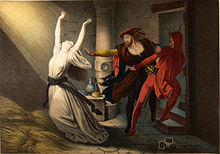Joseph Fay

Joseph Fay (born August 6, 1812 in Cologne , † July 27, 1875 in Düsseldorf ) was a German painter and illustrator of the Düsseldorf School .
Life
Fay studied from 1833 to 1845 at the Düsseldorf Art Academy in the painting class of Karl Ferdinand Sohn , from 1841/42 in the master class of Friedrich Wilhelm von Schadow .
1840 Fay won with Lorenz Clasen , Heinrich Mücke and Hermann Plüddemann 1839 advertised competition of the Art Association of the Rhineland and Westphalia for the fresco cycle The Prehistory of the German to Hermannsschlacht in a hall of Elberfeld Town Hall . From 1843 they carried out their designs. With his fresco Customs and Life of the Old Germans , he painted the first section of the cycle , Fay achieved his artistic breakthrough. The frescoes (destroyed in 1945) brought him numerous exhibition successes and rave reviews. Wolfgang Müller von Königswinter praised the cardboard boxes in the strongest terms and placed them next to Rethel's work: "[...] among the painters [...] there is only one [...] who [...] has a resemblance to Rethel." Fay made his successful debut at an exhibition with his painting Simson and Delilah .
In 1844 Fay went to Paris with two friends from Düsseldorf , where he became a pupil of Paul Delaroche in order to study history painting in particular . He later returned to Düsseldorf, where he no longer undertook any major work. Joseph Fay co-founded the artists' association Malkasten in 1848 . After the revolution of 1848 , Fay, like many other Düsseldorf artist colleagues, withdrew from politically documented history painting and mainly created genre scenes, including the highly theatrical final scene from Goethe's Faust and Mephisto in the dungeon , which he also lithographed , and Italian motifs such as the Bathing Roman women . His landscape backgrounds were often done by August Weber . Occasionally he also worked as an interior designer and privately tutored students, including Charles Wimar .
Through his wife Marie (* 1825), a daughter of the publisher and printer's owner Heinrich Arnz (1785–1854, Arnz & Comp. ), He was brother-in-law of the landscape painters Albert and Otto Arnz . He was also related by marriage to the painters Oswald Achenbach and Albert Flamm , who had married his wife's sisters. Fay was the father and teacher of the animal painter Ludwig Fay .
Two weeks before his 62nd birthday, Joseph Fay died on July 27, 1875 in Düsseldorf.
reception
Composition and painting testify to great understanding as well as technical ability. While historical and romantic themes predominated in his early works, genre painting tended to be more in his later works .
Fay dealt with scenes from the life and goings-on of the Italian people, which he had studied in detail on repeated visits to Italy. His pictures also gain a special charm from the scenic surroundings, which are an essential part of them. They are characterized by a good grasp of things, bright colors and skillful brushwork.
Works
- A listening thisbe
- Romeo and Juliet
- Gretchen in prison
- The night knight , around 1840
Illustrations (selection)
- In: Fairy tales and legends for young and old. - Düsseldorf: Arnz: Voss, 1857.
- Volume 1. Digitized edition of the University and State Library Düsseldorf
- Volume 2. Digitized edition of the University and State Library Düsseldorf
literature
- Moritz Blanckarts : Fay, Josef . In: Allgemeine Deutsche Biographie (ADB). Volume 6, Duncker & Humblot, Leipzig 1877, p. 590 f.
- Fay, Joseph . In: Friedrich von Boetticher : painter works of the nineteenth century. Contribution to art history . Volume I, Dresden 1895, p. 288 f.
- Friedrich Schaarschmidt: History of the Düsseldorf fine arts, especially in the XIX. Century , Art Association for the Rhineland and Westphalia, 1902
- Lisa Hackmann: Fay (Fey), Joseph (Josef) In: Bénédicte Savoy, France France (ed.): Paris apprenticeship years. A lexicon for training German painters in the French capital. Volume 2: 1844-1870. Berlin / Boston 2015
Web links
- Frankfurt Goethe House: Faust and Mephisto in the dungeon, illustrated text passage: Faust - The first part of the tragedy, dungeon
- Joseph Fay, the Forgotten , on old-master-drawings.com, accessed on August 18, 2015
Individual evidence
- ^ Gudrun Haberberger: Wuppertal artist directory . Ed .: Sabine Fehlemann . From the Heydt Museum, Wuppertal 2000, ISBN 978-3-89202-042-4 .
- ↑ In the Wuppertal artist directory it is explicitly pointed out that the frequently mentioned year of birth 1813 is incorrect.
- ↑ Hermann Plüddemann , on kulturportal-west-ost.eu, accessed August 18, 2015
- ↑ Part of the box for the Elberfeld frescoes
- ↑ Legacies / Collections of Herrmann Heinrich Becker , p. 35
| personal data | |
|---|---|
| SURNAME | Fay, Joseph |
| ALTERNATIVE NAMES | Fay, Jupp; Fay, Joseph; Fey, Mathias Joseph (full name) |
| BRIEF DESCRIPTION | German painter |
| DATE OF BIRTH | August 6, 1812 |
| PLACE OF BIRTH | Cologne |
| DATE OF DEATH | July 27, 1875 |
| Place of death | Dusseldorf |

